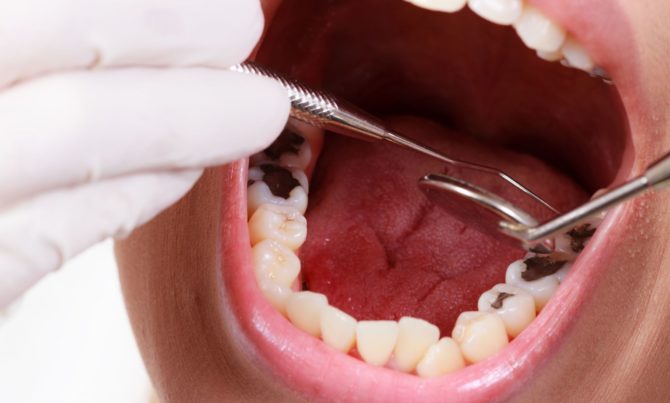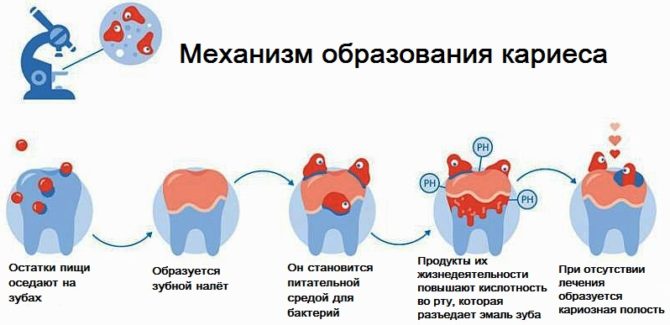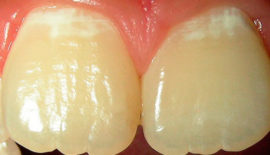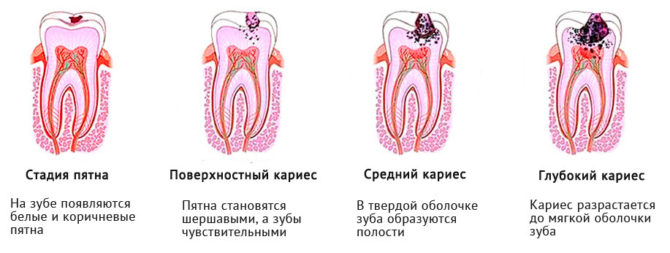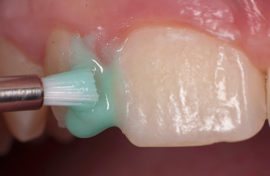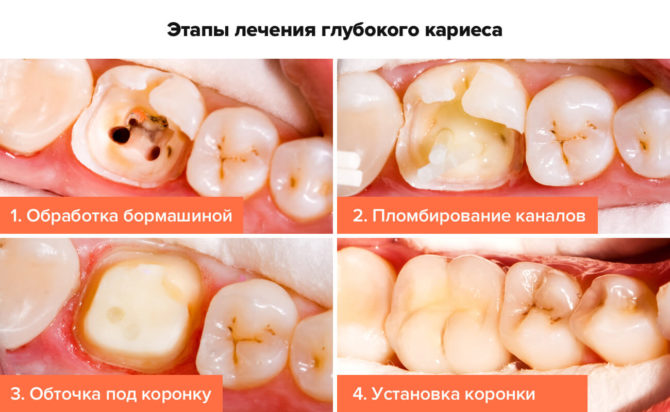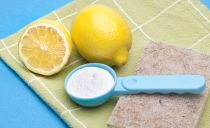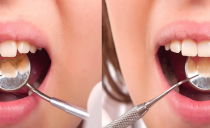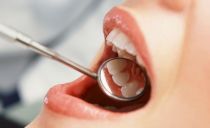Dental caries treatment: how to treat dentistry, stages of caries removal
The process by which the color of tooth enamel changes and the destruction of the hard tissues of the tooth is called caries. This is the most common disease of a dental nature. Various factors lead to damage to the tooth surface, in the first place in popularity - non-compliance with hygiene standards.
There are several stages of development of dental caries, the stages of treatment depend on their severity. The first degree pathology is most easily treated - superficial. If the disease is started, the tooth is most often removed.
Content
Causes of oral caries
The root cause of the cavity is the destructive activity of bacteria that live in the mouth. Partial removal of them occurs when brushing your teeth. To do this, choose a paste that contains fluoride. It not only cleans the tooth surface, but also strengthens the upper tissues of the tooth: dentin and enamel.
Harmful microorganisms can multiply quickly even after proper brushing, the following factors contribute to this:
- Irregular oral care procedures. No matter how thoroughly a person brushes his teeth, if the procedures are irregular, he faces numerous dental problems.
- The use of an insufficient amount of foods rich in vitamins, minerals, as well as the introduction of a large number of muffins, sweets in the diet is not only harmful to the digestive tract, but also creates an ideal environment for the development of bacteria in the mouth.
- If the water you drink has a low content of components necessary for healthy teeth, then the enamel will begin to break down. In this case, we are talking about such minerals as calcium, phosphorus.
- As a result of rickets, tuberculosis, the protective shell of the tooth is destroyed. A dark spot on the enamel indicates the appearance of caries.
- The decrease in the protective function of the body, gastrointestinal tract disease, increased acidity - all this leads to the initial stage of tooth damage.
Stages of the development of pathology
The initial period of the development of enamel damage is quite difficult to determine, in this the dentist helps patients. To establish the presence of the disease, you will have to undergo an examination. By staining the top layer of enamel and the results of studies using ultraviolet radiation, radiography, the dentist will not only determine the stage of dental caries, but also develop a plan for how to treat it.
At the initial stage, an external discoloration of the protective membrane may occur, but the patient will not feel pain. This is the so-called superficial caries. It is poorly defined visually, the doctor will detect changes using ultraviolet diagnostics.
Shallow caries in dentistry clinics are treated with simple remineralizing agents.
Medium caries requires a more serious approach: opening a tooth with a drill, cleaning the tooth canals, using filling material. With such a disease, the patient has a pronounced destruction of enamel and bone tissue, sometimes he feels pain, especially during a meal.
Deep dentin lesions are visible to the naked eye. With them, the development of pulpitis arises, so the patient can not tolerate pain and immediately consults a doctor.Radiography is done at the clinic, and if it makes sense, the dentist will put a seal. When the disease is started, the tooth is removed.
Dental caries treatment
Many patients do not visit a doctor just because any treatment for this disease is painful. In the post-Soviet space, the removal of caries, up to the filling of the teeth, was really carried out without anesthesia. But today, dentists treat tooth decay using high-quality painkillers.
Due to the large selection of injectable anesthesia, a suitable medicine can be selected even for a patient with an allergic reaction to many drugs. There are painkillers that can be used by pregnant women, people with diseases of the heart system.
Different doctors treat caries: the dentist can cure the disease at an early stage, and the advanced pathology, in which a complex course is observed, up to a deep damage to the bone tissue, is treated either by a dentist or surgeon.
How is dental caries treated at a dentist: stages
The effective elimination of caries is to use various treatment methods depending on the form of the disease. You can remove carious lesions from the external coating of the tooth with the help of remineralizing gelssaturated with potassium, magnesium, fluorine and calcium ions. If pathology affects dentin, then you will have to use a drill and put a seal.
Stages of caries treatment:
- First, the preparation of the oral cavity is carried out: cleaning of all teeth or just operated on plaque, tartar.
- Before you fix the problem, you need to anesthetize the tooth. Under anesthesia, the patient will calmly transfer all the drilling and filling procedures. Today, both local and general anesthesia can be used.
- After the lapse of time, when the injection begins to act, you can proceed to the preparation: opening the tooth and removing all tissues affected by caries stains. At this stage, a drill is used.
- Carious cavity is dried and treated with special antiseptics. An insulating pad is applied, which has a long anti-inflammatory and antimicrobial effect. Insulating pads are always placed in case of deep caries, as they can prevent inflammation of the nerve, as well as in cases where the filling material can be irritating to the pulp.
- Then do adhesive treatment and fill the diseased tooth. After installing the seal, it is corrected, polished and polished. This stage is extremely important, since the frozen filling material can injure the soft tissues surrounding the tooth, and plaque accumulates in the cracks on its surface.
With advanced stages of caries, pulpitis may occur, in which case the tooth is often removed.
The photo below schematically shows how doctors remove caries:
Effective treatment of dental caries with folk methods at home
Traditional medicine is effective only in the first stage of the disease. This is the stage when treatment can be carried out without the intervention of a dentist, it will not be possible to cure deep lesions on its own.
Since ancient times, various infusions, herbs that kill pathogenic microflora in the oral cavity have been used to reduce tooth sensitivity. Many recipes are used now.
- Propolis chew with severe pain. It relieves inflammation, cleans teeth from plaque and slows down the destruction of dental tissue.
 Sage is also famous for these properties. To prepare the rinse, take 35 g of grass and 0.5 ml of water. The broth is brewed, insisted and rinsed with their mouth five times a day.
Sage is also famous for these properties. To prepare the rinse, take 35 g of grass and 0.5 ml of water. The broth is brewed, insisted and rinsed with their mouth five times a day.- A solution is also prepared from calamus root and used to rinse the mouth. To do this, make a tincture of 225 g of raw materials and vodka. After a week of insisting, rinse the mouth with a solution before bedtime.
- Schisandra is an excellent antibacterial agent, it is used to increase immunity and fight against pathogenic bacteria. It is enough to brew tea and before you take a sip, rinse your mouth with it.
- To relieve painful symptoms, camphor oil should be applied to a small piece of cotton swab, applied to a diseased tooth and left for an hour and a half.
- Remove pathogenic microflora and muffle pain using novocaine rinses. Two hundred milliliters of 10 percent novocaine is mixed with fresh egg whipped with a mixer, a teaspoon of salt. Rinse the mouth for 7 minutes.
How to prevent caries
To permanently get rid of problems with caries, you need to visit a dentist regularly. In addition, it is necessary to carry out a number of preventive measures:
- Eat a healthy diet. It is advisable to eat fruits, vegetables, fish, seafood, dairy products, because for the normal development and functioning of dental tissues, fluorine, calcium, phosphorus and other minerals are needed.
- Avoid taking hot, cold food at the same time, otherwise the enamel may be damaged. The outer shell of the tooth after large temperature changes gradually deteriorates.
- At least once every six months, check with your dentist for diseases related to dentistry.
- Observe oral hygiene, use effective anti-plaque agents. Choose a toothpaste with comprehensive protection, sometimes use antiseptic rinses to remove harmful microorganisms.
Thanks to these simple tips, the condition of your teeth will be perfect, and you do not need to treat deep lesions of the dental tissue, which costs a lot of money.

